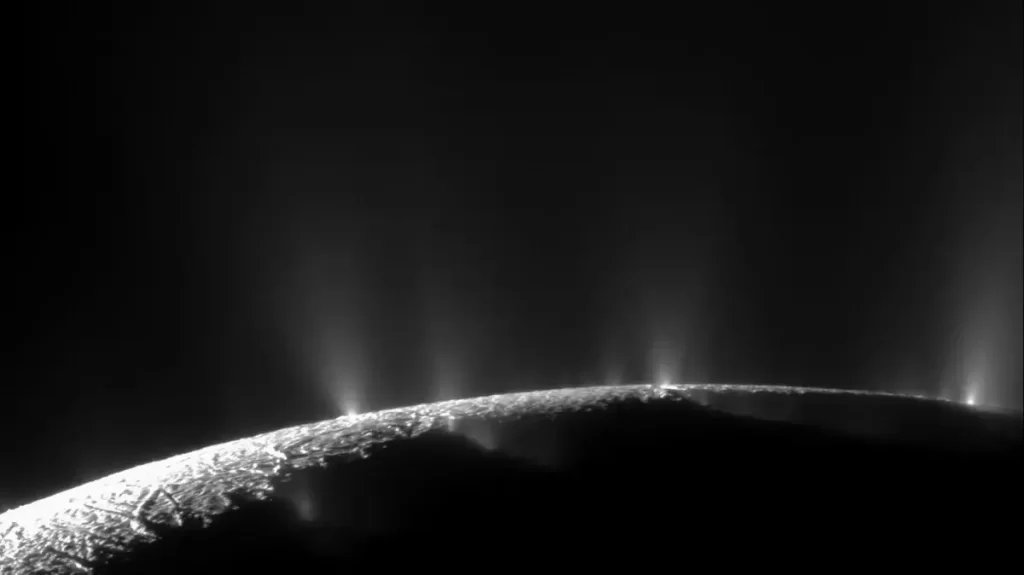
This Saturn moon gushes water beyond scientists’ wildest dreams (Image Credit: Mashable)
Saturn’s moon Enceladus spews geyser-like plumes of water vapor more than 6,000 miles above its surface, roughly the distance of New York to Seattle and back.
Enceladus — about 800 million miles away and 25 times smaller than Earth — has captured the imaginations of planetary scientists searching for life beyond the blue marble. Its constant volcanic spray creates a misty halo in space, which contributes to Saturn’s rings.
A study of the moon using the James Webb Space Telescope, a collaboration of NASA and the European and Canadian space agencies, has provided new insight into how it supplies water for the entire Saturnian system. Scientists hope such research will help them better understand the ocean world’s potential for hosting microscopic life.
In the research team’s telescope observations, they found the moon whipping water jets as it orbited Saturn every 33 hours, said Geronimo Villanueva, lead author of the research recently accepted for publication(opens in a new tab) in Nature Astronomy, in a statement(opens in a new tab).
They never expected to find such massive sprays: Previous telescopes saw jets hundreds of miles(opens in a new tab) from Enceladus’ surface — nowhere in the ballpark of what Webb revealed. Rather, the new team discovered the small moon to be gushing about 79 gallons per second, a rate that could fill an Olympic swimming pool in a couple of hours.
“Not only was the plume huge, but there was just water absolutely everywhere,” Villanueva said.
“Not only was the plume huge, but there was just water absolutely everywhere.”
For comparison, the doughnut-shape plume is 20 times the diameter of Earth’s moon(opens in a new tab). The team’s research shows about 30 percent of that water stays in Enceladus’ wake, but the other 70 percent escapes to supply the rest of the system, which scientists are finding is teeming with moons. A group of astronomers recently announced the discovery of 62 more moons orbiting the sixth planet from the sun, bringing its total natural satellites up to 145.
Want more science and tech news delivered straight to your inbox? Sign up for Mashable’s Light Speed newsletter today

Credit: NASA / JPL-Caltech
When Enceladus, a small world just over 300 miles wide, was first studied in 1980 by NASA’s Voyager 1 probe, it didn’t appear as much more than a little snowball. More recently, researchers have learned the moon’s thick layer of ice conceals a saltwater ocean, spewing methane, a gas that usually comes from bacteria and other microorganisms on our home planet. Between 2005 and 2017, NASA’s crewless Cassini spacecraft flew through Saturn’s rings and moons, revealing an abundance of new information.
Scientists have pushed NASA to endorse future missions to explore the world, requesting financial support to land on its surface. One such proposal, the Enceladus Orbilander(opens in a new tab) designed by Johns Hopkins Applied Physics Laboratory in Maryland, would study it from the moon’s ground — as well as from space — over a 1.5-year period beginning in the 2050s. The complex mission would cost an estimated $2.5 billion(opens in a new tab), according to The Planetary Society, a nonprofit focused on advancing space science.
Meanwhile, the Webb team will revisit Enceladus next year to study specific habitability indicators, looking for organic signatures and hydrogen peroxide. Scientists are particularly interested in the latter because it has the potential to provide much more “potent” sources(opens in a new tab) of metabolic energy, said Christopher Glein, a planetary geochemist who will lead the future study, in a statement.
“The observations could help us determine if Orbilander can access ocean samples near the equator,” he said, “which may help us get back to Enceladus sooner.”





